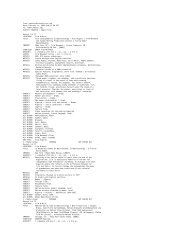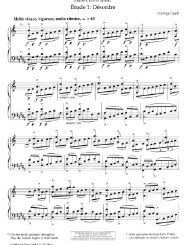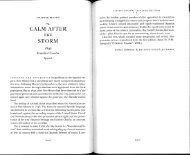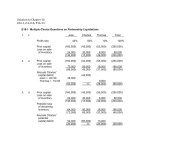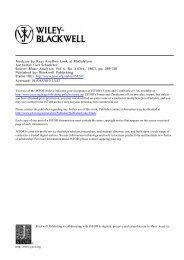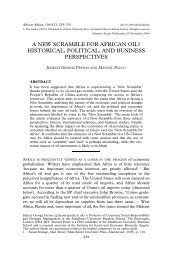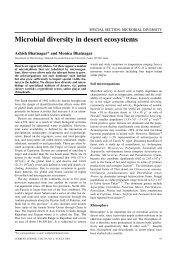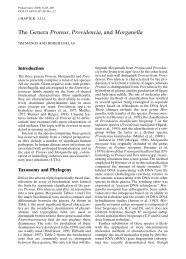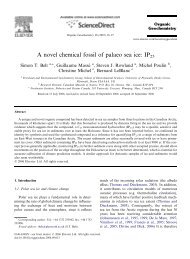The Genus Serratia
The Genus Serratia
The Genus Serratia
Create successful ePaper yourself
Turn your PDF publications into a flip-book with our unique Google optimized e-Paper software.
CHAPTER 3.3.11 <strong>The</strong> <strong>Genus</strong> <strong>Serratia</strong> 233<br />
Table 4. Differential characteristics of <strong>Serratia</strong> species.<br />
Characteristic S. marcescens<br />
Red pigment d − v v − − − −<br />
Potato-like odor − − − v + + − −<br />
Good growth at 5°C − + + − + + + +<br />
Good growth at 40°C + − − v ND ND + ND<br />
Indole − − − − + − − −<br />
Tetrathionate reduction d + − − − − − +<br />
Gas from glucose agar − + v − − − − v<br />
β-Xylosidase − − v + + v − +<br />
Oxidation of: Glucose to gluconate (without cofactor) b + − v + + + + −<br />
2-Ketogluconate to 2,5-diketogluconate + d − − − − − −<br />
Acid from:<br />
Adonitol v − − + (+) + + +<br />
L-Arabinose − + + + + + − +<br />
Lactose d v (+) + (+) v − +<br />
D-Melibiose − + + + + + − +<br />
D-Raffinose d + + + d + −+<br />
L-Rhamnose − − − − + + − v<br />
D-Sorbitol + + d − + + − +<br />
Sucrose + + + + d + + −<br />
D-Xylose − + + + + + d d<br />
Lysine decarboxylase + + − d + − − +<br />
Ornithine decarboxylase + + − − d − − +<br />
Arginine decarboxylase − d − − − − − −<br />
Tween 80 hydrolysis + + + + − + + +<br />
Carbon source utilization:<br />
Adonitol + d − + + + + +<br />
L-Arabinose − + + + + + − +<br />
D-Arabitol − − − + − + d +<br />
L-Arabitol + − − − + + d +<br />
Betaine − − v + − − − −<br />
Dulcitol − − − − − − − +<br />
meso-Erythritol d − − + d + −+<br />
Maltitol − + + + − + − v<br />
Melezitose − + + d − + − −<br />
D-Melibiose − + + + + + − +<br />
Palatinose − + + + − + − +<br />
Quinate d − + (+) − + d −<br />
L-Rhamnose − d − − + + − +<br />
D-Sorbitol + + v − + + − +<br />
Sucrose + + + + d + + −<br />
D-Tartrate − − − d d − − v<br />
Tricarballylate − − − d − − − v<br />
Trigonelline d − − + + v − −<br />
a <strong>The</strong> liquefaciens group or complex includes S. liquefaciens, S. proteamaculans, and S. grimesii.<br />
Without addition of pyrroloquinoline quinone. All species produce gluconate from glucose in the presence of pyrroloquinoline<br />
quinone.<br />
b Symbols: +, positive for 90% or more strains in 2-day reading; −, negative for 90% or more strains in 4-day reading; d, test<br />
used to differentiate biotypes; v, variable reactions; ( ), 4-day reading; ND, not determined.<br />
tests can help to sort out these “atypical” strains:<br />
after examining more than 5,000 <strong>Serratia</strong> strains,<br />
we have found no S. liquefaciens, no S. grimesii,<br />
and no S. plymuthica strains that were able to<br />
grow on adonitol and erythritol and no S.<br />
rubidaea strains able to grow on sorbitol as sole<br />
carbon source.<br />
“liquefaciens<br />
group” a<br />
S. plymuthica<br />
S. rubidaea<br />
S. odorifera<br />
S. ficaria<br />
Identification of <strong>Serratia</strong> Biogroups<br />
and Biotypes<br />
S. entomophila<br />
S. fonticola<br />
Biotypes in <strong>Serratia</strong> marcescens, S. proteamaculans,<br />
S. plymuthica, and S. rubidaea were first<br />
defined by numerical taxomony (Grimont et al.,<br />
1977b). We recognize 18 biotypes in S. marce-



